Development of new functional materials for next-generation batteries
LiFePO4 glass-ceramic cathode for lithium-ion batteries
We are proposing a “glass-ceramics method” to fabricate phosphate-based active materials for lithium-ion batteries. In especially LiFePO4 is intensively focused due to their safety performance in lithium cells recently. We succeeded to fabricate LiFePO4 precursor glass and fully crystallized LiFePO4 ceramics. The glass-ceramics technique has the advantage to reduce the raw-materials cost as well as process cost. Fe(III)2O3 is suitable to make stable precursor glass without any byproducts (HCl, Cl2, SOx, NOx gas and aqueous solution). LiFePO4 glass-ceramics is a promising candidate in next-generation batteries.

Na2FeP2O7 for minor-metal free sodium-ion batteries
In early 2012, we also developed Na2FeP2O7 new candidate cathode for sodium-ion batteries by the glass-ceramics route. Na2FeP2O7 glass-ceramics cathode exhibits 3.0 V and 91 mAh/g (at 0.1C for 97 mAh/g theoretical capacity) for sodium metal anode with non-aqueous electrolyte. Their cyclic performance is well efficiency as 93-96% up to 100 times. Na2FeP2O7 is a promising candidate to realize minor-metal-free batteries. 

Development of an all-solid-state sodium-ion battery composed of oxide glass-ceramics
Recently, Nippon Electric Glass Co., Ltd. and our research group have succeeded in producing an all-solid-state sodium-ion battery that operates at room temperature.
Sodium-ion batteries are expected as an alternative to lithium-ion batteries, which are vulnerable to thermal runaway and have problems with rising raw material prices. From the beginning, we believe that an all-solid-state battery using oxides is ideal from a practical viewpoint, and have proposed an all-solid-state battery that utilizes the viscous flow of oxide glass in the manufacturing process. The prototype cell has the following characteristics.
- Both electrolyte and the glass-ceramic positive electrode can achieve rare metal-free.
- It can be easily joined by co-firing at 550 ℃.
- The prototype all-solid-state battery operates stably without peeling of the bonding interface even when tested over 600 charge-discharge cycles at the time of paper submission.
- Extremely high stability against severe overcharge of 9 V.
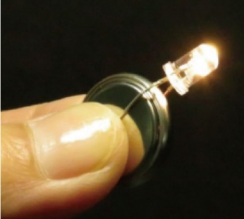
Development of position selective crystallization process of glass by laser and its application to develop prototype devices
Techniques of laser-induced crystallization and development of photonics devices
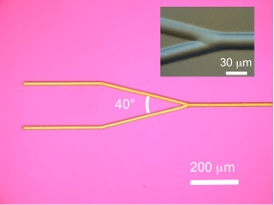
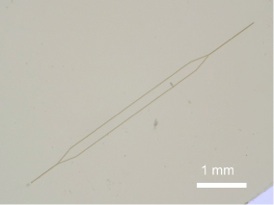
We succeeded in the writing of nonlinear optical curved lines at the surface of Sm2O3-Bi2O3-B2O3 glasses by irradiation of continuous-wave Nd:YAG laser. Figure shows the polarization optical microscope image for the crystal-lines with Y-blanched shapes. This technique demonstrating the possibility of the writing of not only optical wave-guides but also optical switch or optical modulator with any designed patterns
More complicated structure (2D and 3D structure)

We are trying to make a more complicated structure in glass such as planner crystal and single crystal in glass-fiber. The morphology of crystal architecture depends on the glass-composition, laser condition (power, scanning speeds, times). We show you the micrograph of planner type LiNbO3 single crystal architecture on glass surface fabricated by continuous scanning laser process like an ink-jet printer. Planer LiNbO3 architecture has a c-axis orientation parallel to the scanning direction.
Development of transparent glass-ceramics
For Non-linear optics
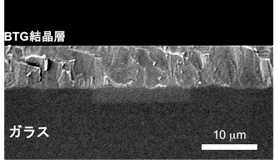
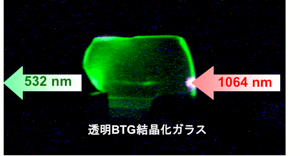
We developed new glass systems and compositions which lead to the formation of ferroelectric crystals. Optical nonlinear Ba2TiGe2O8 crystals can be formed on BaO-TiO2-GeO2 glass substrates (surface crystallized glass) by conventional heat treatment and indicate self-organized c-axis orientation. Ba2TiGe2O8(BTG) surface crystallized glass is showing a strong second harmonic wave. We found strong optical nonlinearity which is the same as LiNbO3 crystal from BTG surface crystallized glass at first.
Processing techniques of glass
Assembling of glass materials by chemical processing

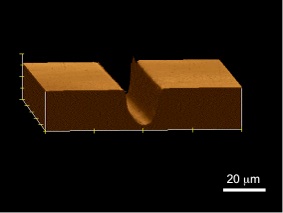
We are developing a nanofiber probe consist of transparent ferroelectric nano-sized glass ceramics and a U-shaped micro groove formed by a combination of laser irradiation and chemical etching process. We’ve been examined the basic study of assembling using chemical processing for glass and glass-ceramics.
